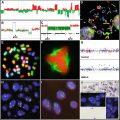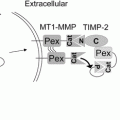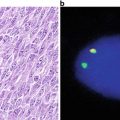Fig. 1.1
Cancer incidence and mortality by site for both sexes (USA, 2015). The relative contributions of the major forms of cancer to overall cancer incidence and cancer-related mortality (both sexes combined) were calculated from data provided by Siegel et al. [3]. Cancers of the reproductive organs include those affecting the prostate, uterine corpus, ovary, uterine cervix, vulva, vagina, testis, penis, and other organs of the male and female genital systems. Cancers of the digestive system include those affecting esophagus, stomach, small intestine, colon, rectum, anus, liver, gallbladder, pancreas, and other digestive organs. Cancers of the respiratory system include those affecting lung, bronchus, larynx, and other respiratory organs.
Estimated cancer incidence by cancer site for males and females are shown in Fig. 1.2. Among men, cancers of the prostate, respiratory system (lung and bronchus), and digestive system (colon and rectum) occur most frequently. Together, these cancers account for 61 % of all cancers diagnosed in men. Prostate is the leading site, accounting for 220,800 new cases and 26 % of cancers diagnosed in men (Fig. 1.3). Among women, cancers of the breast, respiratory system (lung and bronchus), and digestive system (colon and rectum) occur most frequently. Cancers at these sites combine to account for 58 % of all cancers diagnosed in women. Breast is the leading site for cancers affecting women, accounting for 231,840 new cases and 29 % of all cancers diagnosed in women (Fig. 1.3).

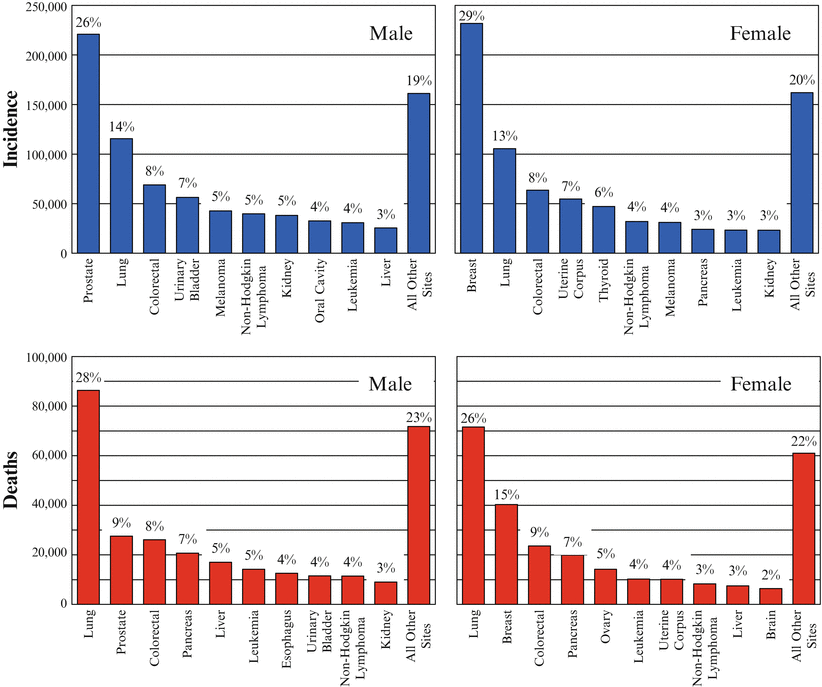

Fig. 1.2
Cancer incidence and mortality by site (USA, 2015). The relative contributions of the major forms of cancer to overall cancer incidence and cancer-related mortality for males and females were calculated from data provided by Siegel et al. [3]. Cancers of the male reproductive organs include testis, penis, and other organs of the male genital system. Cancers of the female reproductive organs include those affecting the uterine corpus, ovary, uterine cervix, vulva, vagina, and other organs of the female genital systems. Cancers of the digestive system include those affecting esophagus, stomach, small intestine, colon, rectum, anus, liver, gallbladder, pancreas, and other digestive organs. Cancers of the respiratory system include those affecting lung, bronchus, larynx, and other respiratory organs.

Fig. 1.3
Cancer incidence and mortality by leading site (USA, 2015). The numbers of cancers (and percentage of total cancers) and numbers of cancer-related deaths (and percentages of cancer-related deaths) for the leading sites for males and females were calculated from data provided by Seigel et al. [3]. The numbers provided for lung include tumors of the lung and bronchus, and numbers for colorectal cancer include tumors of the colon and rectum.
1.3.2 General Trends in Cancer Mortality in the USA
Mortality attributable to invasive cancers produced 589,430 cancer deaths in 2015. This reflects 312,150 male cancer deaths (53 % of total) and 277,280 female cancer deaths (47 % of total). Estimated numbers of cancer deaths by site for both sexes are shown in Fig. 1.1. The leading cause of cancer death involves tumors of the respiratory system (162,460 deaths), the majority of which are neoplasms of the lung and bronchus (158,040 deaths). The second leading cause of cancer deaths involve tumors of the digestive system (149,300 deaths), most of which are tumors of the colorectum (49,700 deaths), pancreas (40,560 deaths), stomach (10,720 deaths), liver and intrahepatic bile duct (24,550 deaths), and esophagus (15,590 deaths). Together, cancers of the respiratory and digestive systems account for 53 % of cancer-associated death.
Trends in cancer mortality among men and women mirror in large part cancer incidence (Fig. 1.2). Cancers of the prostate, lung and bronchus, and colorectum represent the three leading sites for cancer incidence and cancer mortality among men (Fig. 1.3). In a similar fashion, cancers of the breast, lung and bronchus, and colorectum represent the leading sites for cancer incidence and mortality among women (Fig. 1.3). While cancers of the prostate and breast represent the leading sites for new cancer diagnoses among men and women (respectively), the majority of cancer deaths in both sexes are related to cancers of the lung and bronchus (Fig. 1.3). Cancers of the lung and bronchus are responsible for 28 % of all cancer deaths among men and 26 % of all cancer deaths among women (Fig. 1.3). The age-adjusted death rate for lung cancer among men increased dramatically during the six decades between 1930 and 1990, while the death rates for other cancers (like prostate and colorectal) remained relatively stable (Fig. 1.4). However, since 1990, the age-adjusted death rate for lung cancer among men has decreased, although it remains very high compared to all other cancers. The lung cancer death rate for women increased in an equally dramatic fashion since about 1960, becoming the leading cause of female cancer death in the mid-1980s after surpassing the death rate for breast cancer (Fig. 1.4).
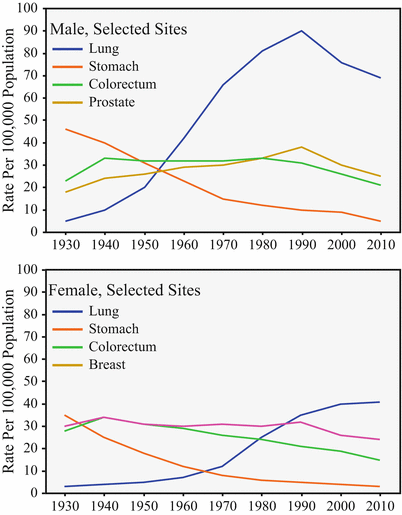

Fig. 1.4
Age-adjusted cancer mortality by site. The age-adjusted death rates for males and females for selected sites were adapted from the data provided by Seigel et al. [3]. Death rates are per 100,000 population and are age-adjusted to the 2000 standard population of the USA.
1.4 Global Cancer Incidence and Mortality
1.4.1 Current Trends in Cancer Incidence and Mortality Worldwide
The IARC estimates that 12,667,500 new cancer cases were diagnosed worldwide in 2008 [4]. This number of new cases represents 6,629,100 male cancer cases (52 %) and 6,038,400 female cancer cases (48 %). Mortality attributed to cancer for the same year produced 7,571,500 deaths worldwide [4]. This reflects 4,225,700 male cancer deaths (56 %) and 3,345,800 female cancer deaths (44 %). The leading sites for cancer incidence worldwide in 2008 included cancers of the lung (1,609,000 new cases), breast (1,383,500 new cases), colorectum (1,233,700 new cases), stomach (989,600 new cases), and prostate (903,500 new cases; Fig. 1.5). The leading sites for cancer mortality worldwide in 2008 included cancers of the lung (1,378,400 deaths), stomach (738,000 deaths), liver (695,900 deaths), colorectum (608,700 deaths), and breast (458,400 deaths; Fig. 1.5). As can be seen, lung cancer accounted for the most new cancer cases and the most cancer deaths among men and women combined during this period of time (Fig. 1.5). The leading sites for cancer incidence among males worldwide included cancers of the lung (1,095,200 new cases), prostate (903,500 new cases), colorectum (663,600 new cases), stomach (640,600 new cases), and liver (522,400 new cases). Combined, cancers at these five sites account for nearly 48 % of all cancer cases among men [4]. The leading causes of cancer death among men included tumors of the lung (951,000 deaths), liver (478,300 deaths), stomach (464,400 deaths), colorectum (320,600 deaths), and esophagus (276,100 deaths). Deaths from these cancers account for 59 % of all male cancer deaths [4]. The leading sites for cancer incidence among females included breast (1,383,500 new cases), colorectum (570,100 new cases), cervix uteri (529,800 new cases), lung (513,600 new cases), and stomach (349,000 new cases). The leading causes of cancer death among females directly mirrors the leading causes of cancer incidence: breast (458,400 deaths), lung (427,400 deaths), colorectum (288,100 deaths), cervix uteri (275,100 deaths), and stomach (230,000 deaths). Combined, these five cancer sites accounted for approximately 55 % of all female cancer cases and 51 % of female cancer deaths [4].


Fig. 1.5
Worldwide cancer incidence and mortality by leading site. The numbers of cancers (and percentage of total cancers) and numbers of cancer-related deaths (and percentages of cancer-related deaths) for the leading sites worldwide were calculated from data provided by Jemal et al. [4]. The numbers provided for lung include tumors of the lung and bronchus and the numbers for colorectal cancer include tumors of the colon and rectum.
1.4.2 Geographic Differences in Cancer Incidence and Mortality
Cancer incidence and mortality differs between developed and developing countries [4]. In 2008, developed countries accounted for 43.9 % of new cancers (5,560,000 cases) and 36.3 % of cancer deaths (2,751,400 deaths), whereas developing countries accounted for 56.1 % of new cancers (7,107,600 cases) and 63.7 % of cancer deaths (4,820,100 deaths). The leading sites for cancer occurrence among men from developed countries include prostate (648,400 new cases), lung (482,600 new cases), and colorectum (389,700 new cases). In contrast, the leading sites for cancer occurrence among men from developing countries include lung (612,500 new cases), stomach (466,900 new cases), and liver (440,700 new cases). The incidence of prostate cancer and liver cancer provide excellent examples of differences in incidence between men from developed and developing countries. In 2008, prostate cancer affected 648,400 men in developed countries (ranked first for cancer incidence in this cohort) compared to 255,000 men in developing countries (ranked sixth for cancer incidence in this cohort). Likewise, in 2008, liver cancer affected 440,700 men in developing countries (ranked third for cancer incidence in this cohort) compared to 81,700 men in developed countries (ranked tenth for cancer incidence in this cohort). While incidence rates vary, lung cancer represents the most frequent cause of cancer death among men from both developed and developing countries. Among women, breast cancer is the most frequent site of cancer in both developed (692,200 new cases) and developing countries (691,300 new cases) in 2008. Likewise, lung cancer occurs frequently in both groups—241,700 new cases in developed countries (ranked third for cancer incidence) and 272,000 new cases in developing countries (ranked third for cancer incidence). However, significant differences in cancer incidence among women from developed and developing countries can be seen for cancer of the cervix. Women from developing countries develop cervical cancer frequently (453,300 new cases, ranked second for cancer incidence), while women in developed countries develop cervical cancer less often (76,500 new cases, ranked tenth for cancer incidence).
New cancer incidence and cancer-related mortality can differ tremendously from world area to world area, country to country, and even from region to region within a single country. The leading world areas for new cancer cases includes Eastern Asia/China (17.3 % of new cases), North America (14.9 % of new cases), South Central Asia (11.6 % of new cases), Eastern Europe (10.4 % of new cases), and Western Europe (8.3 % of new cases). Collectively, Asia accounted for approximately 40 % of all new cancer cases worldwide in 1990 [5]. Recognizing the significant contribution of the population density of China and other regions of Asia to these numbers of cancers, it is appropriate to consider the cancer burden of these countries after correction for population. The numbers of cases/deaths and the incidence/mortality rates for these world regions in 1999 are given in Fig. 1.6. It is evident from the data contained in Fig. 1.6 that there is a marked disparity between total numbers of cancer cases/deaths and the incidence/mortality rate for specific world regions [5]. In 2012, men from Australia/New Zealand exhibit the highest cancer incidence rate worldwide (365 cases per 100,000 population), followed closely by men from North America (344 cases per 100,000 population) and Western Europe (344 cases per 100,000 population), while the lowest cancer incidence rate is found among men from Western Africa (79 cases per 100,000 population) [6]. While demonstrating the highest cancer incidence rate worldwide, the male populations of Australia/New Zealand, North America, and Western Europe rank 13th, 9th, and 5th (respectively) for cancer mortality rate, possibly reflecting the relative quality and availability of healthcare and treatment options among the various world regions [6]. The highest cancer mortality rate for men is found in Central/Eastern Europe (173 deaths per 100,000 population), followed by Eastern Asia (159 deaths per 100,000 population), Southern Europe (138 deaths per 100,000 population), Southern Africa (137 deaths per 100,000 population), and Western Europe (131 deaths per 100,000 population), while the lowest mortality rate is found among men from West Africa (69 deaths per 100,000 population) [6]. The North American female population shows the highest cancer incidence rate worldwide (295 cases per 100,000 population), followed by Australia/New Zealand (278 cases per 100,000 population), Northern Europe (264 cases per 100,000 population), and Western Europe (264 cases per 100,000 population), while the lowest incidence rate is found among women from South/Central Asia (103 cases per 100,000 population) [6]. The highest mortality rate for females worldwide is found in Melanesia (119 deaths per 100,000 population), followed by Eastern Africa (111 deaths per 100,000 population), Southern Africa (99 deaths per 100,000 population), Northern Europe (94 deaths per 100,000 population), and Polynesia (93 deaths per 100,000 population), while the lowest mortality rate is found among women from Micronesia (56 deaths per 100,000 population) [6].
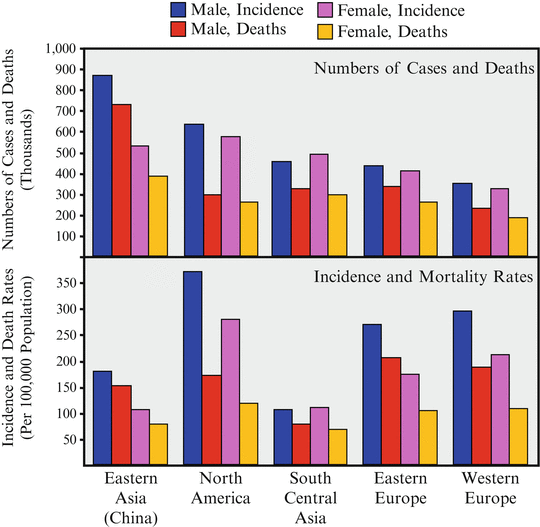

Fig. 1.6
Worldwide cancer incidence and mortality for both sexes by world region. The total numbers of cancers and cancer-related deaths, and the total incidence of cancer and cancer-related mortality rates for selected world regions were calculated from data provided by Parkin et al. [5].
1.5 Population Factors Contributing to Cancer Incidence and Mortality
1.5.1 Age-Dependence of Cancer Incidence and Mortality
Cancer is predominantly a disease of old age. Most malignant neoplasms are diagnosed in patients over the age of 65, making age the most important risk factor for development of many types of cancer [7, 8]. The age-specific incidence and death rates for cancers of the prostate, breast (female), lung (both sexes combined), and colorectum (both sexes combined) for the period of 1992–2012 [2] are shown in Fig. 1.7. The trends depicted in this figure clearly show that the majority of each of these cancer types occur in individuals of advanced age. In the case of prostate cancer, 86 % of all cases occur in men over the age of 65, and 99.5 % occur in men over the age of 50. Likewise, 97 % of prostate cancer deaths occur in men over the age of 65 (Fig. 1.7). In contrast, female breast cancer occurs much more frequently in younger individuals. Nonetheless, 63 % of cases occur in women over the age of 65, and 88 % of cases occur in women over the age of 50 (Fig. 1.7). A notable exception to this relationship between advanced age and cancer incidence involves some forms of leukemia and other cancers of childhood. Acute lymphocytic leukemia (ALL) occurs with a bimodal distribution, with highest incidence among individuals less than 20 years of age, and a second peak of increased incidence among individuals of advanced age (Fig. 1.8). The majority of ALL cases are diagnosed in children, with 40 % of cases diagnosed in children under the age of 15, and 45 % of cases occurring in individuals under the age of 20. Despite the prevalence of this disease in childhood, a significant number of adults are affected. In fact, 32 % of ALL cases are diagnosed in individuals over the age of 65 years of age. In contrast to ALL, the other major forms of leukemia demonstrate the usual pattern of age-dependence observed with solid tumors, with large numbers of cases in older segments of the population (Fig. 1.8). Among 54,270 new cases of leukemia in 2015, 88 % (48,020 new cases) represent forms of leukemia that primarily affect older individuals (acute myeloid leukemia, chronic myeloid leukemia, or chronic lymphocytic leukemia), with the remainder (6250 new cases) reflecting childhood ALL.
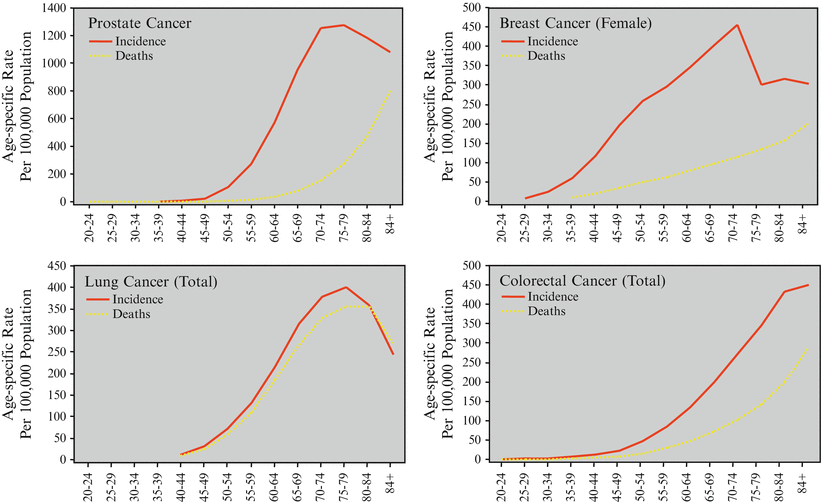
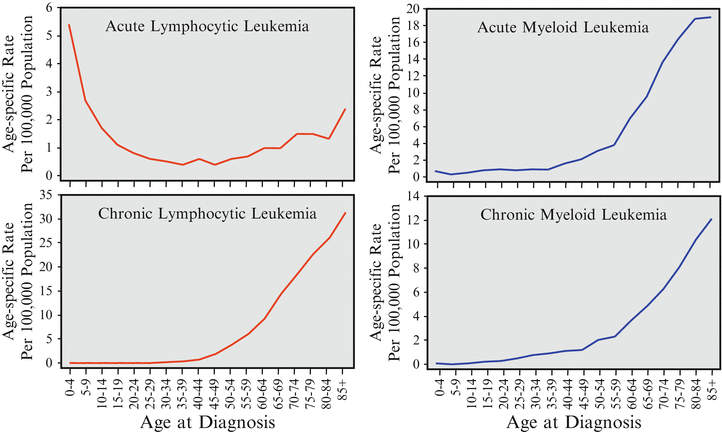

Fig. 1.7
Age-specific incidence and mortality rates for selected sites, 1992–2012. The age-specific rates for breast cancer incidence and mortality are for females only. The age-specific rates for lung cancer and colorectal cancer are combined for both sexes. These data were adapted from Howlander et al. [2]. Rates are per 100,000 population and are age-adjusted to the 2000 standard population of the USA.

Fig. 1.8
Age-specific incidence rates for acute and chronic leukemias, 1992–2012. The age-specific rates for incidence and mortality for the major forms of leukemia are combined for both sexes. These data were adapted from Howlander et al. [2]. Rates are per 100,000 population and are age-adjusted to the 2000 standard population of the USA.
1.5.2 Cancer Incidence and Mortality by Race and Ethnicity
Cancer incidence and mortality can vary tremendously with race and ethnicity [9]. In the USA, African Americans and Caucasians are more likely to develop cancer than individuals of other races or ethnicities (Fig. 1.9). African Americans demonstrated a cancer incidence for all sites combined of approximately 443 cases per 100,000 population, and Caucasians exhibited a cancer incidence rate of 403 cases per 100,000 population. In contrast, American Indians showed the lowest cancer incidence among populations of the USA with 153 cases per 100,000 population for all sites combined. Mortality due to cancer also differs among patients depending upon their race or ethnicity. Similar to the cancer incidence rates, mortality due to cancer is higher among African Americans (223 per 100,000 population) and Caucasians (167 deaths per 100,000 population) than other populations, including Asian/Pacific Islanders, American Indians, and Hispanics (Fig. 1.9). For both cancer incidence and mortality, racial and ethnic variations for all sites combined differ from those for individual cancer sites. African Americans and Caucasians demonstrate an excess of cancer incidence compared to the general population for a number of primary sites. African Americans exhibit high incidence rates for cancers of the prostate (223 cases per 100,000 population), lung (74 cases per 100,000 population for both sexes combined), colorectum (50 cases per 100,000 population), pancreas (13 cases per 100,000 population), oral cavity and pharynx (13 cases per 100,000), stomach (12 cases per 100,000 population), cervix uteri (12 cases per 100,000 population), and esophagus (8 cases per 100,000 population). The cancer incidence rates for lung, prostate, pancreas, and esophagus among African Americans are 33 %, 47 %, 50 %, and 115 % (respectively) higher than those rates for the general population. Caucasians exhibit high incidence rates for cancers of the breast (113 cases per 100,000 population), uterine corpus (23 cases per 100,000 population), urinary bladder (18 cases per 100,000), ovary (16 per 100,000 population), and melanoma (14 cases per 100,000 population). The excess of melanoma in the Caucasian population compared with populations possessing darker skin pigmentation is clearly shown in Fig. 1.10. The Asian/Pacific Islander population exhibit high rates of liver cancer (11 cases per 100,000 population) and stomach cancer (15 cases per 100,000 population), which are 173 % and 97 % (respectively) higher than the rates for the general population (Fig. 1.10). The Hispanic population demonstrates high rates of incidence for cancers of the cervix uteri (16 cases per 100,000 population) and stomach (11 cases per 100,000 population). These rates are 78 % and 36 % (respectively) higher than rates for these cancers in the general population (Fig. 1.10).

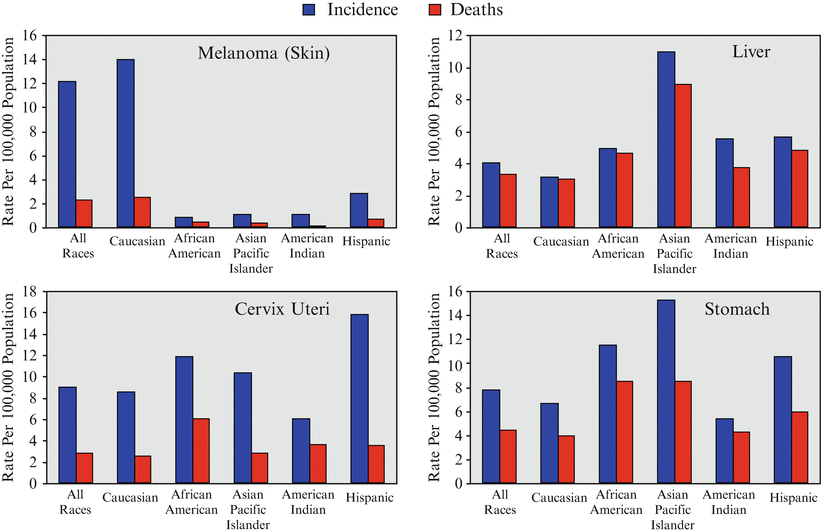

Fig. 1.9
Cancer incidence and mortality by race and ethnicity (USA, 1990–1996). The age-specific rates for cancer incidence and mortality for all races and select ethnicities residing in the USA are given for all cancer sites and select organ-specific cancer sites. The rates for all sites and lung cancer are for both sexes combined. These data were adapted from Reis et al. [9]. Rates are per 100,000 population and are age-adjusted to the 1970 standard population of the USA.

Fig. 1.10
Cancer incidence and mortality by race and ethnicity (USA, 1990–1996). The age-specific rates for cancer incidence and mortality for all races and select ethnicities residing in the USA are given for all cancer sites and select organ-specific cancer sites. The rates for melanoma, and cancers of the liver and stomach are for both sexes combined. These data were adapted from Reis et al. [9]. Rates are per 100,000 population and are age-adjusted to the 1970 standard population of the USA.
1.6 Trends in Cancer Incidence and Mortality for Specific Sites
1.6.1 Lung Cancer
A pproximately 221,200 new cases of lung cancer were diagnosed in the USA in 2015, with 115,610 new cases among men and 105,590 new cases among women, and 13 % of all invasive cancer diagnoses [3]. The relative lung cancer incidence for all races and genders was estimated to be 56 cancers per 100,000 population in 2012 [2]. The relative lung cancer incidence for men (all races) was estimated to be 65 cancers per 100,000 population in 2012, down from the all-time high of 102 cases per 100,000 population in 1984 [2]. African-American men exhibit a higher incidence of lung cancer (90 cancers per 100,000 population in 2012) compared to Caucasian-American men (64 cancers per 100,000 population in 2012). However, lung cancer incidence has declined among both groups from their all-time highs (159 cancers per 100,000 population for African-American men in 1984, and 101 cancers per 100,000 population for Caucasian-American men in 1987). The relative lung cancer incidence rate among women increased to 54 cancers per 100,000 population in 2007, but has been declining since that time, reaching approximately 50 cases per 100,000 population in 2012 [2]. Cancer of the lung and bronchus accounted for an estimated 158,040 deaths in 2015, which represents 27 % of all cancer deaths [3]. Furthermore, lung cancer is the leading cause of cancer deaths among men (86,380 deaths, 28 % of cancer deaths) and women (71,660 deaths, 26 % of cancer deaths) (Fig. 1.3).
Cancers of the lung and bronchus represent 92 % of all respiratory system cancers [3]. The remainder of respiratory system cancers include tumors of the larnyx and nasal cavities. The majority of lung cancers are histologically classified as either small cell lung carcinoma (SCLC, 13 % of all lung cancers) or non-small-cell lung carcinoma (NSCLC, 83 % of all lung cancers). The NSCLC class includes the morphologic subtypes of squamous cell carcinoma (SCC), adenocarcinoma, and large cell undifferentiated carcinoma. Squamous cell carcinomas (SCC) account for approximately 35 % of lung cancers [10]. This histologic subtype of lung cancer is closely correlated with cigarette smoking and represents the most common type of lung cancer among men. SCCs display varying levels of differentiation, from tumors consisting of well-differentiated keratinized squamous epithelium to tumors consisting of undifferentiated anaplastic cells. Adenocarcinomas have increased in frequency in recent years and now account for nearly 35 % of lung cancers [10]. These tumors grow faster than SCCs and frequently metastasize to the brain. Lung adenocarcinomas can present as well-differentiated tumors consisting of well-differentiated glandular epithelium, or as undifferentiated tumors composed of highly mitotic anaplastic cells. Large cell undifferentiated carcinomas account for approximately 15 % of all lung cancers [10]. These tumors lack squamous or glandular cell characteristics and are typically composed of large anaplastic cells with frequent mitotic figures. Clinically, these tumors metastasize early and have a poor prognosis. Small cell lung carcinomas (SCLC) make up the majority of the remaining cancers (13 %) [3, 10]. These cancers are also associated with smoking history. SCLCs tend to produce a variety of neuroendocrine substances that can cause symptoms related to the biological activity of the hormonal substance. About 10 % of SCLCs display a paraneoplastic phenotype related to production of these neuroendocrine effectors [11]. These cancers grow rapidly, metastasize early, and have a very poor prognosis.
The majority of lung cancers are attributable to exposure to known carcinogenic agents, particularly cigarette smoke. Several lines of evidence strongly link cigarette smoking to lung cancer. Smokers have a significantly increased risk (11- to 22-fold) for development of lung cancer compared to nonsmokers [12], and cessation of smoking decreases the risk for lung cancer compared to continued smoking [12, 13]. Furthermore, heavy smokers exhibit a greater risk than light smokers, suggesting a dose-response relationship between cigarette consumption and lung cancer risk [12, 13]. Numerous mutagenic and carcinogenic substances have been identified as constituents of the particulate and vapor phases of cigarette smoke, including benzo[a]pyrene, dibenza[a]anthracene, nickel, cadmium, polonium, urethane, formaldehyde, nitrogen oxides, and nitrosodiethylamine [14]. There is also evidence that smoking combined with certain environmental (or occupational) exposures results in potentiation of lung cancer risk. Urban smokers exhibit a significantly higher incidence of lung cancer than smokers from rural areas, suggesting a possible role for air pollution in development of lung cancer [15]. Occupational exposure to asbestos, bis(chloromethyl) ether, chromium has been associated with increased risk for development of lung cancer [16, 17]. Exposure to the radioactive gas radon has been suggested to increase the risk of lung cancer development. This gas is ubiquitous in the earth’s atmosphere, creating the opportunity for exposure of vast numbers of people. However, passive exposure to the background levels of radon found in domestic dwellings and other enclosures are not sufficiently high to increase lung cancer risk appreciably [18, 19]. High level radon exposure has been documented among miners working in uranium, iron, zinc, tin, and fluorspar mines [20, 21]. These workers show an excess of lung cancer (compared to non-miners) that varies depending upon the radon concentration encountered in the ambient air of the specific mine [20, 21].
Therapy for lung cancer varies depending upon the tumor type and other clinical variables (tumor stage, grade, location, and size). Surgery is the preferred treatment choice for SCC and adenocarcinoma, whereas SCLC is generally treated with chemotherapy. In some cases special treatment modalities are employed, such as chemotherapy followed by surgery or surgery followed by radiation treatment. Despite the variety of treatment modalities that can be applied to lung cancer management, the overall survival rates for affected individuals are not good (Fig. 1.11). The average 5-year survival rate for all patients and all stages of disease is only 17 % [3, 9, 22]. The survival rate increases to 54 % if the disease is detected early (localized), but few lung cancers (15 %) are discovered this early (Fig. 1.12). The majority of lung cancer cases are not detected until after the development of regional spread (27 %) or distant metastases (58 %). The 5-year survival rate for patients with regional disease is 27 %, and this drops to 4 % in patients with distant metastasis (Fig. 1.12). The overall poor probability of surviving lung cancer probably reflects the difficulty with early detection of this tumor (or the failure to detect tumors while localized) and the ineffectiveness of traditional therapies (radiation and chemotherapy). However, over the last decade or so, a variety of targeted drugs have received market approval for treating NSCLC [23]. These new drug modalities for early stage or advanced NSCLC include inhibitors of the epidermal growth factor receptor (gefitinib, erlotinib, and afatinib), the anaplastic lymphoma kinase inhibitor crizotinib, and the antivascular endothelial growth factor receptor monoclonal antibody, bevacizumab [23]. In parallel, molecular alterations of the epidermal growth factor receptor (EGFR) and the anaplastic lymphoma kinase (ALK) have been characterized, enabling the development of molecular diagnostics of discrimination of lung cancer patients that are more likely to benefit from specific targeted therapies versus those patients that will not respond to a specific drug [23].
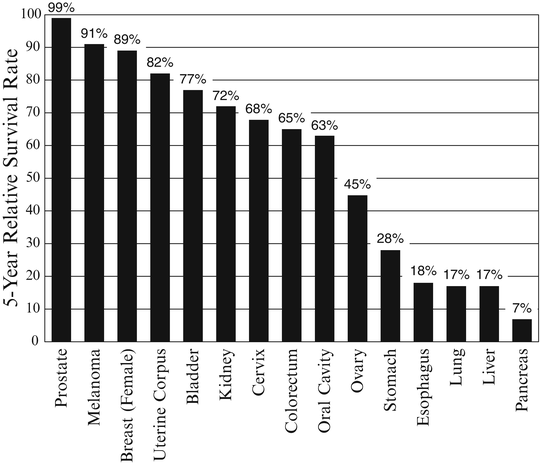
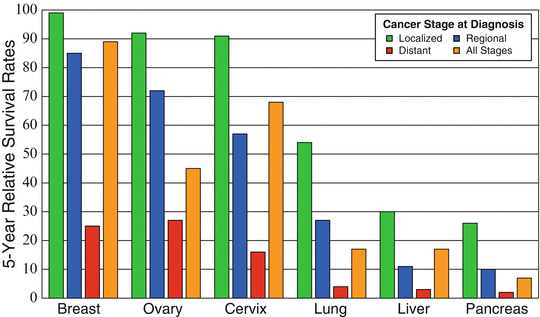

Fig. 1.11
Five-year relative survival rates for invasive cancers (all stages, 2004–2010). The average 5-year survival rates for select invasive cancers (including cancers diagnosed at all stages) among affected individuals residing in the USA for 2004–2010 are shown. These data were adapted from Seigel et al. [3].

Fig. 1.12
Five-year relative survival rates for selected sites by stage at diagnosis. The percentage of tumors for select invasive cancers according to tumor stage at diagnosis and the corresponding 5-year survival rates among affected individuals residing in the USA for 2004–2010 are shown. These data were adapted from Seigel et al. [3].
1.6.2 Colorectal Cancer
Approximately 132,700 new cases of colorectal cancer were diagnosed in the USA in 2015 (approximately 8 % of all cancers), with 69,090 new cases among men and 63,610 new cases among women [3]. Colorectal cancer represent 46 % of all digestive system tumors, and is the third leading site for cancer diagnosis among men (8 % of new cases among men) and women (8 % of new cases among women). In 2012, the relative incidence rate for colorectal cancer was 45 cancers per 100,000 population for men (all races) and 35 cancers per 100,000 for women (all races) [2]. However, colorectal cancer incidence rates vary by race (as well as gender). The overall incidence rates for colorectal cancer among Caucasians in 2012 was 39 cancers per 100,000 population compared to 48 cancers per 100,000 population among African-Americans. African-American men exhibit the highest incidence rate for colorectal cancer at 57 cancers per 100,000 population (versus 43 cancers per 100,000 population for Caucasian men), and colorectal cancer incidence rates for African-American women (41 cases per 100,000 population in 2012) exceed that for Caucasian women (34 cases per 100,000 population in 2012) [2]. Colorectal cancer accounted for an estimated 49,700 deaths in 2015, which represents 8 % of all cancer deaths [3]. Colorectal cancer is the third leading cause of death among men and women, accounting for 8 % and 9 % of all cancer deaths, respectively (Fig. 1.3).
Colorectal tumors are often first recognized as a polyp protruding from the wall of the bowel, which may be either hyperplastic (non-dysplastic) or dysplastic (adenomatous). Hyperplastic polyps consist of large numbers of cells with normal morphology that do not have a tendency to become malignant [24]. Adenomatous polyps contain dysplastic cells that fail to show normal intracellular and intercellular organization. Expanding adenomas become progressively more dysplastic and likely to become malignant. The majority of malignant neoplasms of the colon are thought to be derived from benign polyps. The malignant nature of colorectal tumors are defined by their invasiveness. The major histologic type of colorectal cancer is adenocarcinoma, which account for 90–95 % of all colorectal cancers [25, 26], although other rare epithelial tumor types do occur, including squamous cell carcinomas, adenosquamous carcinomas, and undifferentiated carcinomas which contain no glandular structures or features such as mucinous secretions [25, 27].
There are several recognized risk factors for development of colorectal cancer, some of which are genetic or related to benign pathological lesions of the colorectum, and others that are related to lifestyle or environment. Approximately 5–10 % of colorectal cancers are thought to be related to an inherited predisposition. Familial colorectal cancer can arise in presence or absence of polyposis, which is characterized by the occurrence of multiple benign polyps lining the walls of the colon. Several polyposis syndromes have been described, the major form of which is familial adenomatous polyposis (FAP) [28]. The hereditary nonpolyposis colorectal cancer (HNPCC) syndrome predisposes affected individuals to the development of colorectal cancer, as well as tumors at other tissue sites [29, 30]. These two hereditary syndromes account for a large percentage of familial colorectal cancers. Individuals affected by these syndromes carry mutations in one or more genes that function as tumor suppressor genes or that encode critical components of the DNA repair mechanisms that protect the genome from mutation [28]. Patients with inflammatory bowel disease (ulcerative colitis) or Crohn’s disease (granulomatous colitis) exhibit an increased risk for development of colorectal cancer [28, 31]. Epidemiologic studies indicate that individuals consuming diets that are high in animal fat and red meat [32–34], or low in fiber [35, 36] are associated with increased risk for development of colorectal cancer. In addition, there is some evidence that alcohol intake and cigarette smoking can increase the risk for colorectal cancer [37, 38].
Treatment for colorectal cancer may include surgery, radiation therapy, chemotherapy, or a combination of these treatment modalities. Chemotherapy alone is not very effective, but some drug combinations that are now employed show promise. In general, survival of colorectal cancer is closely correlated with early detection of localized disease, and the mortality due to this disease has been declining in recent years [3, 39]. The average 5-year relative survival rate for colorectal cancer is 65 % (Fig. 1.11). The relative survival rate increases to 90 % if the cancer is detected early (localized), and remains relatively high (71 % survival) when detected with regional metastasis (Fig. 1.12). In contrast, the 5-year survival is only 13 % when the cancer is detected after development of distant metastases [3, 9]. Most colorectal cancers are now detected while localized (40 % of tumors) or with limited regional spread (37 % of tumors), which contributes to the generally favorable probability of survival for this form of cancer. Several screening methods are available for surveillance of patients that are at high risk for development of colorectal cancer, and some screening strategies are now routinely applied to the general population. These screening methods include digital rectal examination, fecal occult blood testing, and various forms of colonoscopy [40].
Stay updated, free articles. Join our Telegram channel

Full access? Get Clinical Tree



